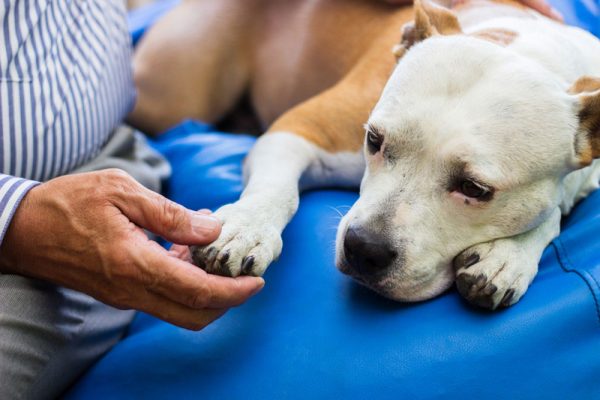Increasingly, CBD products for dogs are becoming the first port of call for owners of dogs suffering from painful, inflammatory, or anxiety-causing conditions.
Thanks to CBD oil’s lack of side effects on dogs, low toxicity, and ability to pair with other treatment courses, it’s helping many pups retain their quality of life while undergoing a chronic issue.
So, how well do dogs with hip dysplasia respond to CBD treatment, and how much evidence is there for, or against, using CBD in this context?
Canine hip dysplasia – An overview
Hip dysplasia can affect any dog, but it’s more prevalent in bigger breeds and is linked to a mix of environmental and dietary factors.
The health of canine hips is closely associated with the amount and type of exercise a dog gets in their life. While often diagnosed with age, dysplasia is not necessarily restricted to older dogs. The beginnings of dysplasia can usually be traced to uneven growth rates in puppyhood. The seeds of hip dysplasia are usually genetic and begin as a puppy’s muscle mass and hormones increase during growth spurts.
The hip is a ball and socket joint, which should fit snugly and move smoothly with a reasonable level of mobility. Dysplasia occurs when space opens up between the ball at the end of the femur and the socket of the hip. In dogs suffering dysplasia, the joint will be loose or underdeveloped, and the two elements will begin to grind against each other.
For most pups (but not all), this grinding will cause progressive pain and inflammation. As symptoms progress, owners often begin to notice changes in the way their dog walks and sits.
To reduce the chance of growth issues—especially in puppies expected to grow larger than 50 pounds—weight and feeding should be closely monitored.
Why consider CBD oil for dogs with hip dysplasia?

Treatment for hip dysplasia should always be determined by a veterinarian. When dogs do present with discomfort from dysplasia, symptoms often stem from inflammation that surrounds the hurting joint.
As a result, many are put on courses of non-steroidal anti-inflammatory drugs (NSAIDs). These drugs are intended to affect hormone-like substances called prostaglandins, which the body releases in response to irritation, injury, or infection. Prostaglandins are largely responsible for initiating pain and inflammation, and so blocking their activity, NSAIDs can often reduce symptoms.
When properly prescribed, NSAIDs are usually safe for dogs, and have minimal side effects. But because they do interfere with prostaglandins, they can mitigate the positive effects of these compounds—the results of which can be serious. In some cases, this can cause kidney, liver, and digestive tract issues.
Common visible side effects of NSAIDs reported to the FDA’s Center for Veterinary Medicine include:
• Vomiting
• Diarrhea
• Lack of interest in food
• Lethargy or low activity level
In rarer cases, things can get more severe, with stomach ulcers, kidney and liver failure reported in some dogs.
Note: Human NSAIDs like aspirin, ibuprofen, naproxen, and acetaminophen should never be given to dogs!
When could CBD oil help with hip dysplasia?
For dogs who present with NSAID side effects, CBD is able to offer equivalent pain and inflammation reduction by utilizing an entirely different pharmacology and biological mechanism.
Working through the body’s endocannabinoid system, CBD is able to affect receptors known to mediate pain, inflammation, and immune response. Research on exactly how CBD interacts with the body’s immune system is ongoing, but the association has been shown in repeated humans and animal trials.
Even for dogs who are on a successful course of treatment, CBD can provide additional, wider benefits, taking out any residual inflammation while also acting on the anxiety and stress that can accompany reduced mobility.
When won’t CBD oil help with hip dysplasia?
 CBD won’t cure dysplasia, and it’s also not a substitute for the many beneficial therapies and lifestyle changes that can make a real difference to dogs with pelvic issues.
CBD won’t cure dysplasia, and it’s also not a substitute for the many beneficial therapies and lifestyle changes that can make a real difference to dogs with pelvic issues.
For example, CBD shouldn’t replace dietary supplements such as vitamin C and vitamin E, which help in their own way to reduce inflammation in the bones and joints (for best results.
Any exercise that helps to move the hips joints in moderation, without increasing pain, can also be beneficial—short walks and swimming are both good options.
At a certain stage of hip dysplasia, both CBD and NSAIDs reach their limits. When the degradation of the joint reaches the point where therapy stops being beneficial and a dog’s daily life is seriously impeded, veterinarians will turn to surgical procedures.
The type of surgery dogs undergo usually depends on their age, lifestyle, and the severity of their disorder. Common options include total hip replacement, femoral head osteotomy, and Dorsal Acetabular Rim-plasty (DARthroplasty), which uses grafts to adjust the way bodyweight rests upon the hip.
The bottom line: CBD for dogs with hip dysplasia
CBD can be an effective alternative to treatment with NSAIDs for many dogs who need to reduce the symptoms of hip dysplasia, but don’t gel well with non-steroidal drugs for one reason or another. Often, best results come from using CBD as a supplement to other treatments and lifestyle changes.
We recommend these CBD oils for dogs in pain & arthritis if you decide to give canine CBD a try.



